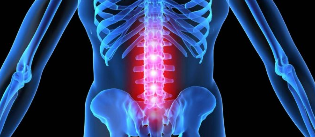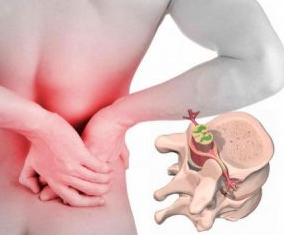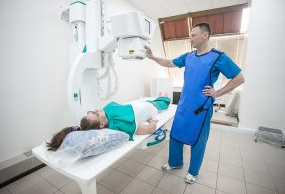Degenerative disease, which destroys the body of the vertebrae and the deformation of the intervertebral disc is called degenerative disc disease of the lumbar spine. The causes of this pathology can be varied, and in order to properly treated, it is important to determine what exactly influenced the progression of deformation in the lower back. If a person is concerned about the typical symptoms of low back pain, need to immediately go to the hospital.
At stage 1 will be able to cure the problem with medication and special exercises, but 2-3 degrees conservative method does not always help, so you have to resort to surgical treatment.

The main reasons
A left or right lumbar osteochondrosis — diseases of degenerative nature that destroys the intervertebral disc, fibrous ring is broken and the person has a hernia, which causes severe pain and dysfunction of musculoskeletal system. To provoke low back pain in the lower back can the following factors:
- increased physical load on the lower spine;
- improper positioning of the body when walking, sitting;
- sedentary, sedentary lifestyle;
- postural;
- traumas, fractures, or contusions, cause degenerative effects in the spine;
- congenital abnormalities of the structure of the musculoskeletal apparatus, in which the signs of strain can already be noticed in a child;
- obesity;
- stress, poor nutrition.
Stages and symptoms
Signs of lumbar osteochondrosis developing as the progression of the disease, and the bigger the stage, the more pronounced the symptom. There are 4 degrees:
- At stage 1 the fibrous ring is damaged slightly, the pain is not expressed and often worries after a long walk. The pain appears 2 — lumbalgia when the symptom worried constantly, and lumbago, in which the symptoms are suddenly.
- POP osteochondrosis of 2 degrees is characterized by a large destruction of the fibrous ring and disc degeneration. Such a violation leads to a decrease in the space between the vertebrae and the compression of the nerve fibers. Progressive stage 2 is accompanied by severe lower back pain in the morning stiffness is felt, which is a long time.
- Stage 3 fibrous ring in the affected area is completely destroyed, which formed the hernia, which obstructs the blood vessels and the spinal nerve roots. Back always hurts, the symptoms don't recede after a rest and reduce stress, there is a tingling sensation and heaviness in the legs. In the third stage is degeneration of muscle fibers, resulting in limited movement of the patient.
- 4 stage spine is completely deformed, a man concerned about a sharp pain where motor activity is fully restricted. Because of the innervation and blood supply appear swelling in the legs, between the vertebrae grow bone formation. On the last degree a high risk of disability.
Syndromes of osteochondrosis of the lumbar spine
Lumbar degenerative disc disease manifested by the following syndromes:
- Pain. This is the main symptom that characterizes a degenerative abnormalities in the spine. Progression of disease symptoms become severe, the attacks can last for several days, adversely affecting human health.
- Radicular. For thinning damaged body of the disc height of the intervertebral space is reduced, causing the vertebrae become unstable, irritating, and squeezing the nerve endings. The person concerned acute pain, inflammation of nerves, a blood disorder. Muscular frame atrophies, causing the functionality of the lower limbs is broken.
- Ischemic. Progressive osteochondrosis of the lumbar leads to that blood vessels and arteries penetrating the spine begin to compress. This disrupts the blood supply and nutrition of internal organs and tissues and becomes a cause of acute pain on the inner side of the thighs, in the crotch area. If the problem is not resolved in a timely manner, may result in paralysis or paresis.
- Spinal. With the progression of pain, coronary and radicular syndrome of the spine of the patient is gradually deformed, which significantly affects the status and well-being. Muscles become weak, changing gait, the person tries to distribute the load on the spine so that when moving experience the minimum of discomfort. Such violations affect the internal organs, while the intervertebral discs continue to deform and be damaged.

If the treatment of degenerative disc disease of the lumbar was inadequate or untimely, can develop dangerous complications. Women in lesions of the vertebrae at the level of L1—S1, complications can arise during pregnancy, especially in the last stages, when the load on the spine is maximum. Men degenerative processes in the lumbar spine are often the cause of impotence problems. Delays in treatment facing reactive spondylosis and a high likelihood of developing osteoarthritis of the knee, the hip joint. Other effects:
- compression-vascular ischemia;
- protrusion;
- spondiloarthrosis;
- paresis.
Diagnosis
The doctor was able to pick up effective methods of treatment, it is necessary to establish an accurate diagnosis. Diagnosis begins in the office of a neurologist, who conducts the primary inspection, palpated the affected area, evaluates the nature of changes in the spine. In the acute period, the patient can hardly move and to perform any complex manipulations. For a more detailed study of the vertebral column is assigned instrumental diagnostics, which includes:
- X-ray radiography. Is performed in 3 projections, images show the degree of progression of the pathology, size of the intervertebral cracks, salt deposits, structure of the vertebrae.
- CT scan or MRI. Give a more detailed picture of the condition of the spine and disc, show irregularities in the soft tissues, which cannot be seen by x-ray.
How to treat the problem?
Medicines
The disease is characterized by progression of the pain symptom with which to cope may not all drugs. In the early stages for the relief of signs can take pain pills. And the problem is treated using special ointments and gels. In advanced cases, such drugs will be ineffective, so the doctor will prescribe injections, due to which pain relief and first aid will be timely.

Nonsteroidal anti-inflammatory drugs help to relieve swelling and inflammation, allowing the nerve fibers and vessels will no longer compress, and the pain symptoms will decrease. The group consists of means:
- Painkillers. With the progression of the acute period, when the pain is pronounced, prescribers in this group. As they have side effects, you should not buy the funds at its discretion. Safe and effective the drug must appoint a physician.
- The muscle relaxants. Relieves muscle spasms, thereby reducing pain and discomfort.
- Corticosteroids. Eliminate the inflammation, positively affect the nervous system, improve the patient's condition in a short time.
Exercises
If diagnosed degenerative disc disease L5—S1, or the affected discs L3—S1, mandatory assigned therapeutic exercises. When performing a training complex, it is important to increase the load gradually to avoid any discomfort and pain. Recommended for osteochondrosis of the following exercises:
- Standing up to make turns left and right, tilts forward and back.
- Standing on all fours, bend and align the back.
- Lying on the floor, lift your feet, without lifting your lower back off the floor.
- In the supine position with the left hand to reach for the limb, which is to the right and Vice versa.
Massage and physiotherapy
Chronic low back pain in remission successfully treated with massage treatments performed by a chiropractor. Massage helps to normalize blood circulation in the affected area, to establish food. Similar effect have physiotherapy:
- electrophoresis;
- magneto-therapy;
- laser therapy;
- UHF.
If patients with left-sided or right-sided low back pain conservative methods have not helped, then surgical intervention is necessary. Most often used microdiscectomy, in which sequestered herniated are removed using microsurgical instruments. Procedure minime psidium, the day after the operation the patient can start to move.
Prevention
As osteochondrosis suffer adults and children, it is important from an early age to follow the spine to control posture, to pay attention, how does the curve when sitting or driving. If there is a suspicion of strain, you should consult a doctor. The sooner the disease is diagnosed, the easier it will be to deal.
















